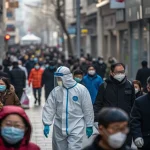As 2022 draws to a close, a retrospective analysis reveals that many of the dire predictions that shadowed the year failed to materialize. Despite widespread concerns about democratic collapse and the potential annihilation of Ukraine, the reality proved less catastrophic than initially feared.
The year began with ominous forecasts following Russia’s full-scale invasion of Ukraine in February. Military experts and political analysts predicted a swift Russian victory and the potential erasure of Ukraine as an independent nation. However, Ukrainian forces mounted an unexpectedly strong resistance, preserving their sovereignty despite significant territorial losses.
Democracy Under Pressure
Warnings about democracy’s demise echoed throughout political discourse in 2022. Election denialism, rising authoritarianism, and weakening democratic institutions fueled concerns in numerous countries. Yet democracy demonstrated resilience in several key tests:
- Brazil’s peaceful transfer of power despite election controversies
- The United States’ midterm elections proceeding without major disruptions
- Pro-democracy movements gaining momentum in Iran and other authoritarian states
While democratic backsliding remains a concern in countries like Hungary and Turkey, the wholesale collapse of democratic systems did not occur as some had predicted. Instead, many democratic institutions bent but did not break under pressure.
Ukraine’s Surprising Resilience
“The destruction of Ukraine” was widely anticipated in the early days of the Russian invasion. Military analysts predicted Kyiv would fall within days. Instead, Ukrainian forces repelled the initial assault on the capital and later recaptured significant territory in the east and south.
The war has caused immense suffering, with thousands dead and millions displaced. Critical infrastructure has been damaged by Russian strikes, leaving many Ukrainians without heat or electricity during winter months. However, the nation has maintained its independence and governmental functions despite these challenges.
“Ukraine has not only survived but has shown extraordinary national unity in the face of aggression,” noted one security expert familiar with the conflict.
Other Fears That Failed to Materialize
Beyond geopolitics, other predicted catastrophes showed more nuance than initially feared. The anticipated post-pandemic economic collapse gave way to a mixed picture of inflation concerns balanced against strong employment numbers in many countries.
Climate change continued its worrying trajectory, but international cooperation on environmental issues showed signs of life at COP27, even if concrete actions remained insufficient. The predicted collapse of global supply chains eased, though disruptions continued in some sectors.
Public health experts had warned of new pandemic waves that might rival COVID-19’s initial impact. While new variants emerged, vaccination campaigns and improved treatments helped limit their severity in most regions.
This pattern of “better than feared” outcomes doesn’t suggest an absence of serious problems. Rather, it highlights how worst-case scenarios often fail to account for human adaptability, institutional resilience, and unexpected developments that can alter predicted trajectories.
As the world enters 2023, many challenges remain unresolved. The war in Ukraine continues with no clear end in sight. Democratic institutions face ongoing threats. Economic uncertainties persist. Yet the lessons of 2022 suggest that doom-laden predictions should be viewed with cautious skepticism rather than resigned acceptance.









